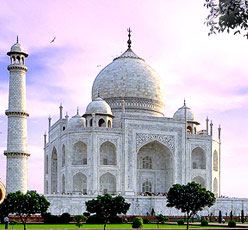 On the outskirts of Hyderabad, the grandiose Golconda fort stands as the quintessence of Nawabi culture and majesty. Built in
1525 by Mohammed Quli Qutub Shah, it speaks of a great cultural heritage
of 400 years. The acoustic system of the Golconda Fort, the structural
grandeur of its palaces and the ingenious water supply system are
legendary examples of the architectural skills that have been put in its
construction. It was once famous as a rich diamond mine in the medieval
times and it is believed to be the place where the famed 'Kohinoor'
diamond is said to have come from. The meticulous details of its
architecture, sprawling lawns and gardens complete with fountains
catches the attention of the onlookers. Built on a 120 m high granite
hill, it is surrounded by crenulated masonry ramparts weighing several
tonnes.
On the outskirts of Hyderabad, the grandiose Golconda fort stands as the quintessence of Nawabi culture and majesty. Built in
1525 by Mohammed Quli Qutub Shah, it speaks of a great cultural heritage
of 400 years. The acoustic system of the Golconda Fort, the structural
grandeur of its palaces and the ingenious water supply system are
legendary examples of the architectural skills that have been put in its
construction. It was once famous as a rich diamond mine in the medieval
times and it is believed to be the place where the famed 'Kohinoor'
diamond is said to have come from. The meticulous details of its
architecture, sprawling lawns and gardens complete with fountains
catches the attention of the onlookers. Built on a 120 m high granite
hill, it is surrounded by crenulated masonry ramparts weighing several
tonnes.The ventilation of the place has been so designed to let the cool breeze cool down the place in the summers and the massive gates are studded with large pointed iron spikes to prevent elephants of the enemy trying to force in through the gates. In more prosperous times, the 10-km long road from Golconda to outer Hyderabad was a world-renowned market for jewellery, diamonds, pearls and other gems. The Golconda Fort has been the seat of Deccan rulers since 13th century till Hyderabad was founded in the 16th century. It was founded originally by the Kakatiyas as a mud fort and was expanded later by the Qutub Shahi kings who turned it into a massive fort of granite. The chief attractions of the fort are its system of acoustics, which ensures that even a hand clap at below the dome at the entrance can be heard clearly at the 'Bala Hissar', the highest point almost a kilometre away, palaces, the famous 'Rahban' cannon, the tombs of the Qutub Shahi kings, and the Sound and Light show conducted by Andhra Pradesh Tourism.









